

Surfin’ the Tile
Last month we reported on waterfalls and the earth’s saturation here
on Fitch Mountain in Northern California. Locally, March has proven
to be one of the wettest months on record. Hence we’re now surfin’
our way…. to Orlando and the Coverings exposition where you’ll
find us in Booth 2816, under the flags as guests of the Tile Council
of North America. Surfin’? It’s our theme this year at Coverings,
so ride the wave over, say hello, hang ten and enjoy a free hot dog!
During a free moment at Coverings check out “Historic Tiles in
Architecture,” a video presentation produced by Tile Heritage in
cooperation with AVI. You’ll find us on the big screen in the lobby
of the Orange County Convention Center, opposite Registration. Our
special thanks to Coverings for sponsoring the production. Please let
us know how you like it!
We are pleased to announce the publication of Tile Heritage: A Review
of American Tile History, vol. 8, no. 1, titled “Tiles in the Twin
Cities,” dedicated to the THF symposium held in Minneapolis and
Saint Paul in 2002. With our second Minnesota conference upcoming
this fall, the timing of this publication couldn’t be more perfect.
We are especially grateful to our four contributors—Marcia Anderson,
Tim Counts, Sharon Darling and Tom O’Sullivan—for their
scholarship and for their perseverance, having submitted their work
to Tile Heritage over three years ago. Each of the articles is
flawlessly written, reflecting over 100 years of Minnesota history.
The journal will be in the mail to THF members by the middle of the
first week in April.
“Tiles of the Northern Plains: Building on Tradition” will be held
in Duluth and Minneapolis September 13-17. Mark you calendar! The
program will commence in both cities simultaneously with a series of
glass, mosaic and tile making workshops in Minneapolis and a tour to
historic sites in Superior (Wisconsin) and Duluth that will include a
visit to the 42-room Victorian Fairlawn Mansion and an evening at
Glensheen, the quintessential Arts & Crafts estate of Chester and
Clara Congden. All attending will come together on Thursday evening
for a reception at Clay Squared to Infinity in Minneapolis for the
awarding of prizes in the national juried tile exhibition, “One
Square Foot.” On Friday the Minneapolis Institute of Arts will roll
out the red carpet in celebration of its newly completed addition,
and we will be engaged there during the day sitting in on our
lectures of choice and touring the magnificent museum in between.
Friday evening we’ll be gathering at the Holiday Inn for dinner and
a keynote address by Eric Astrachan, Executive Director of the Tile
Council of North America. On Saturday the 16th we will participate in
the 5th annual Minnesota Tile Festival at the American Swedish
Institute presented by the Handmade Tile Association, which is co-
presenting the conference with Tile Heritage. It’s going to be a
full and exciting program! Please plan on joining us!
On March 21st Ceramic Tile Design in San Rafael, California hosted an
informative glass tile seminar presented by Scott Fleming, Director
of Technical Services at Oceanside Glasstile, Carlsbad, California.
In many ways the event resembled a celebration for the near complete,
beautiful, transformation of the Ceramic Tile Design showroom. About
eighty people attended—a fine mix of contractors, designers,
architects and other colleagues-in-tile, all enjoying the yummy,
gourmet Dogs ’n Suds, accompanied by some great music from the
resident company band,
THF member and company principal Steve Cerami and showroom manager
Therese Brown recently invited Tile Heritage to provide a “history
wall” as a feature in the new showroom. There are numerous pictures
of California installations as well as a glass top display case of
historic California tiles on loan from the Foundation’s collection.
Ceramic Tile Design may well be on its way to becoming a THF “Tile
Joint.” Our warmest thanks to all at CTD for their vision of drawing
together tile history with contemporary design.
Mud brick, dried in the sun, was one of the first building materials.
It is conceivable that on the Nile, Euphrates, or Tigris rivers,
following floods, the deposited mud or silt cracked and formed cakes
that could be shaped into crude building units to build huts for
protection from the weather. In the ancient city of Ur, in
Mesopotamia (modern Iraq), the first true arch of sun-baked brick was
made about 4000 BC. The arch itself has not survived, but a
description of it includes the first known reference to mortars other
than mud. A bitumen slime was used to bind the bricks together.
Burned brick, no doubt, had already been produced simply by
containing a fire with mud bricks. In Ur the potters discovered the
principle of the closed kiln, in which heat could be controlled. The
ziggurat at Ur is an example of early monumental brickwork perhaps
built of sun-dried brick; the steps were replaced after 2,500 years
(about 1500 BC) by burned brick.
As civilization spread eastward and westward from the Middle East, so
did the manufacture and use of brick. The Great Wall of China (210
BC) was built of both burned and sun-dried bricks. Early examples of
brickwork in Rome were the reconstruction of the Pantheon (AD 123)
with an unprecedented brick and concrete dome, 43 metres (142 feet)
in diameter and height, and the Baths of Hadrian, where pillars of
terra cotta were used to support floors heated by roaring fires.
Enameling, or glazing, of brick and tile was known to the Babylonians
and Assyrians as early as 600 BC, again stemming from the potter's
art. The great mosques of Jerusalem (Dome of the Rock), Isfahan (in
Iran), and Tehran are excellent examples of glazed tile used as
mosaics. Some of the blues found in these glazes cannot be reproduced
by present manufacturing processes.
Western Europe probably exploited brick as a building and
architectural unit more than any other area in the world. It was
particularly important in combating the disastrous fires that
chronically affected medieval cities. After the Great Fire of 1666,
London changed from being a city of wood and became one of brick,
solely to gain protection from fire.
Bricks and brick construction were taken to the New World by the
earliest European settlers. The Coptic descendants of the ancient
Egyptians on the upper Nile River called their technique of making
mud brick tobe. The Arabs transmitted the name to the Spaniards, who,
in turn, brought the art of adobe brickmaking to the southern portion
of North America. In the north the Dutch West India Company built the
first brick building on Manhattan Island in 1633.
Basically, the process of brickmaking has not changed since the first
fired bricks were produced some thousands of years ago. The steps
used then are used today, but with refinements. The various phases of
manufacture are as follows: securing the clay, beneficiation [see
below], mixing and forming, drying, firing, and cooling.
Hard-burned brick should be used for face work exposed to the
weather, and soft brick for filling, foundations, and the like. The
mainstay standard US brick measures approximately 8 x 4 x 2.25 inches
(203 x 102 x 57 millimeters), and has a crushing strength of between
1000 and 3000 lbf/in² (7 to 21 megapascals) depending on quality. The
modern standard UK brick size is 215 x 102.5 x 65 millimetres.
A highly impervious and ornamental surface may be laid on brick
either by salt glazing, in which salt is added during the burning
process, or by the use of a "slip," which is a glaze material into
which the bricks are dipped. Subsequent reheating in the kiln fuses
the slip into a glazed surface integral with the brick base.
Regardless of size, bricks are usually manufactured with the depth
equal to half the length (assuming that the brick is laid
horizontally), in a 1:2:4 ratio. This allows for several convenient
layouts that must necessarily interweave the bricks in any structure,
often both at the corners and within the wall depth in order to
ensure the greatest possible durability of the structure.
(Available each month to Tile Heritage members who e-mail the Foundation from the address they
would like
E-News sent to. Contact: foundation@tileheritage.org)
PRINTED VERSION

Here’s What’s Below:
“Tiles in the Twin Cities”
Minnesota Tile Conference
Ceramic Tile Design
History of Brick Making
Playing with Clay…Words
Coming next: Tiles and Mosaics in Chicago
Surfin’ the Tile, San Francisco Style!

"Tiles in the Twin Cities”

Minnesota Tile Conference… just ahead!

Ceramic Tile Design Welcomes History
 the CTD Spacers. A great time was had by all!
the CTD Spacers. A great time was had by all!
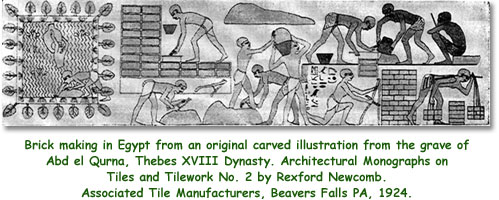
History of Brick Making
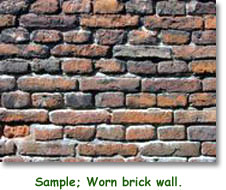
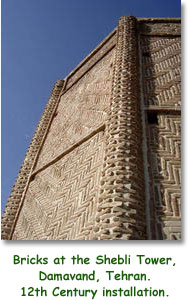
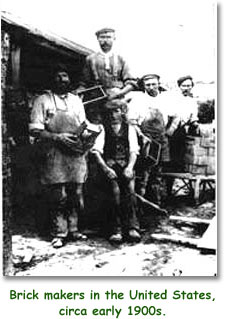
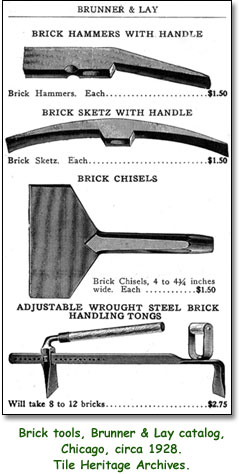
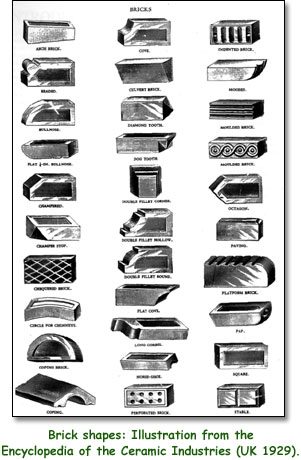
Size and Proportions
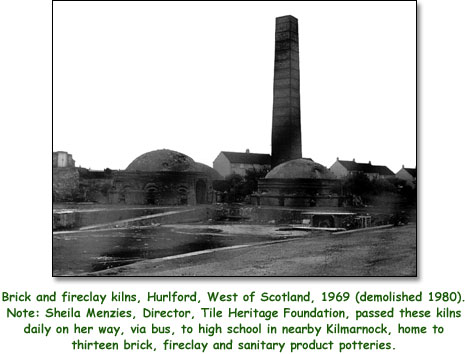
Sources: The information in the above article was drawn from the Tile
Heritage archive, Wikipedia online and The Encyclopedia Britannica
online.